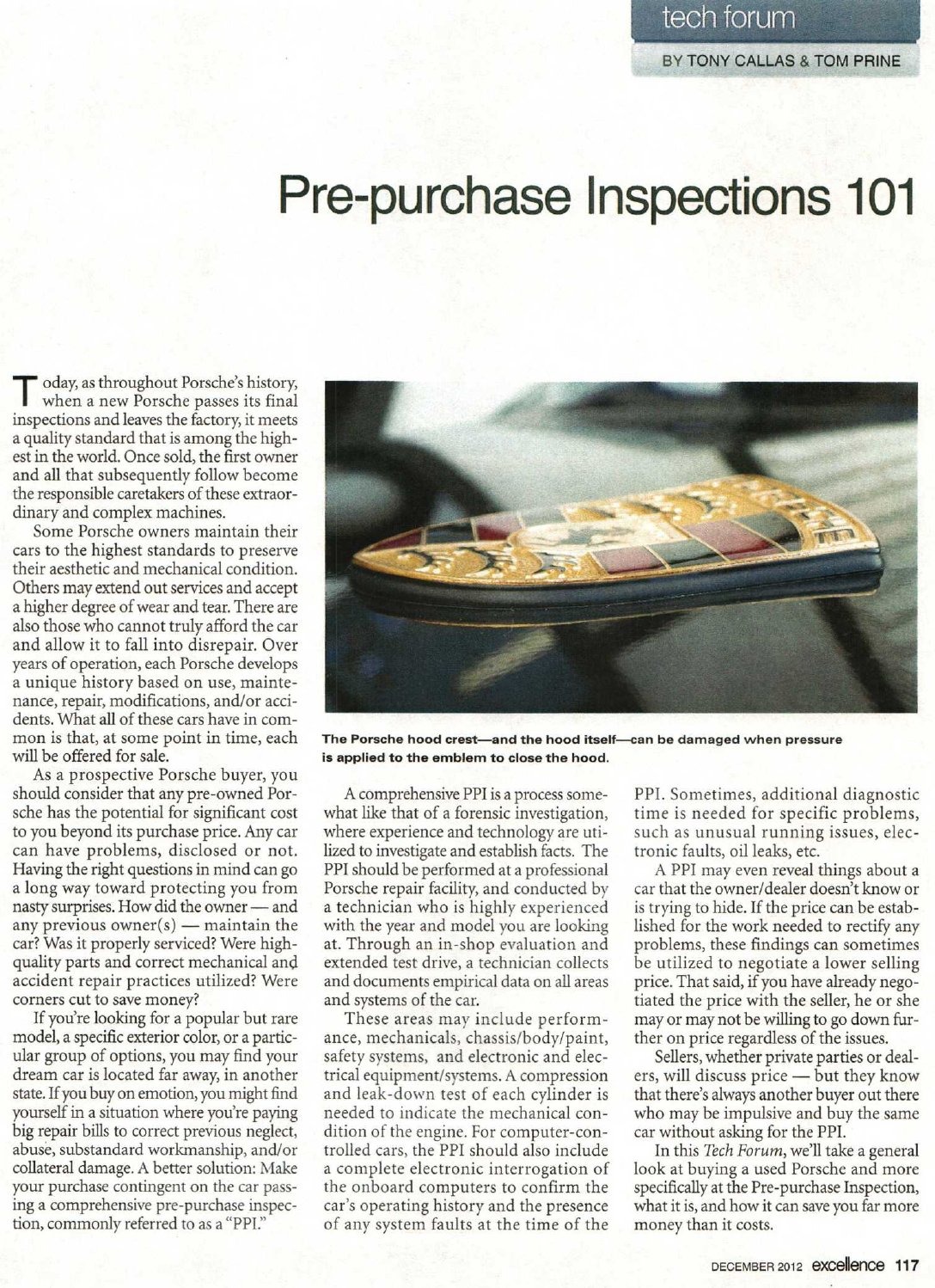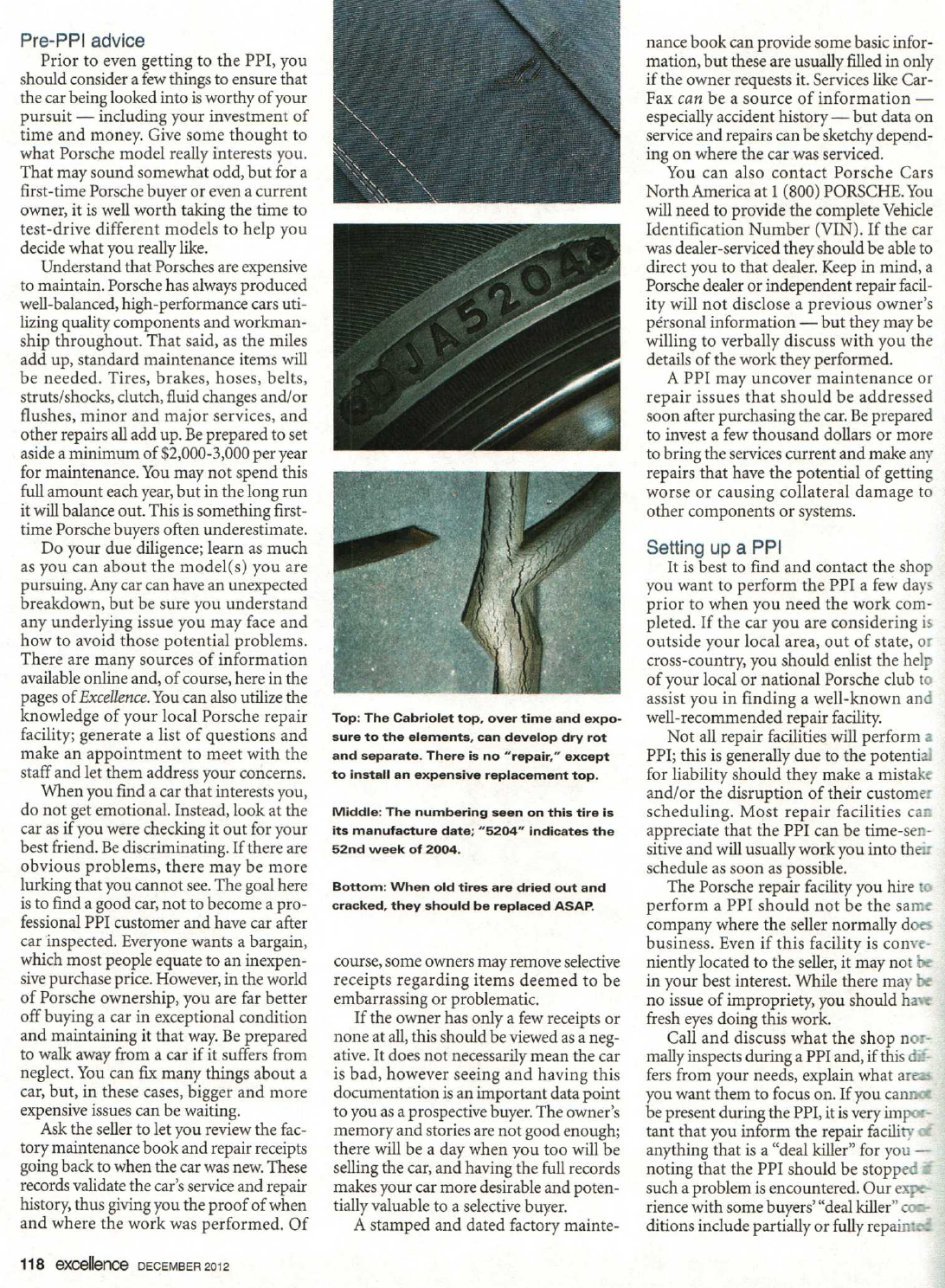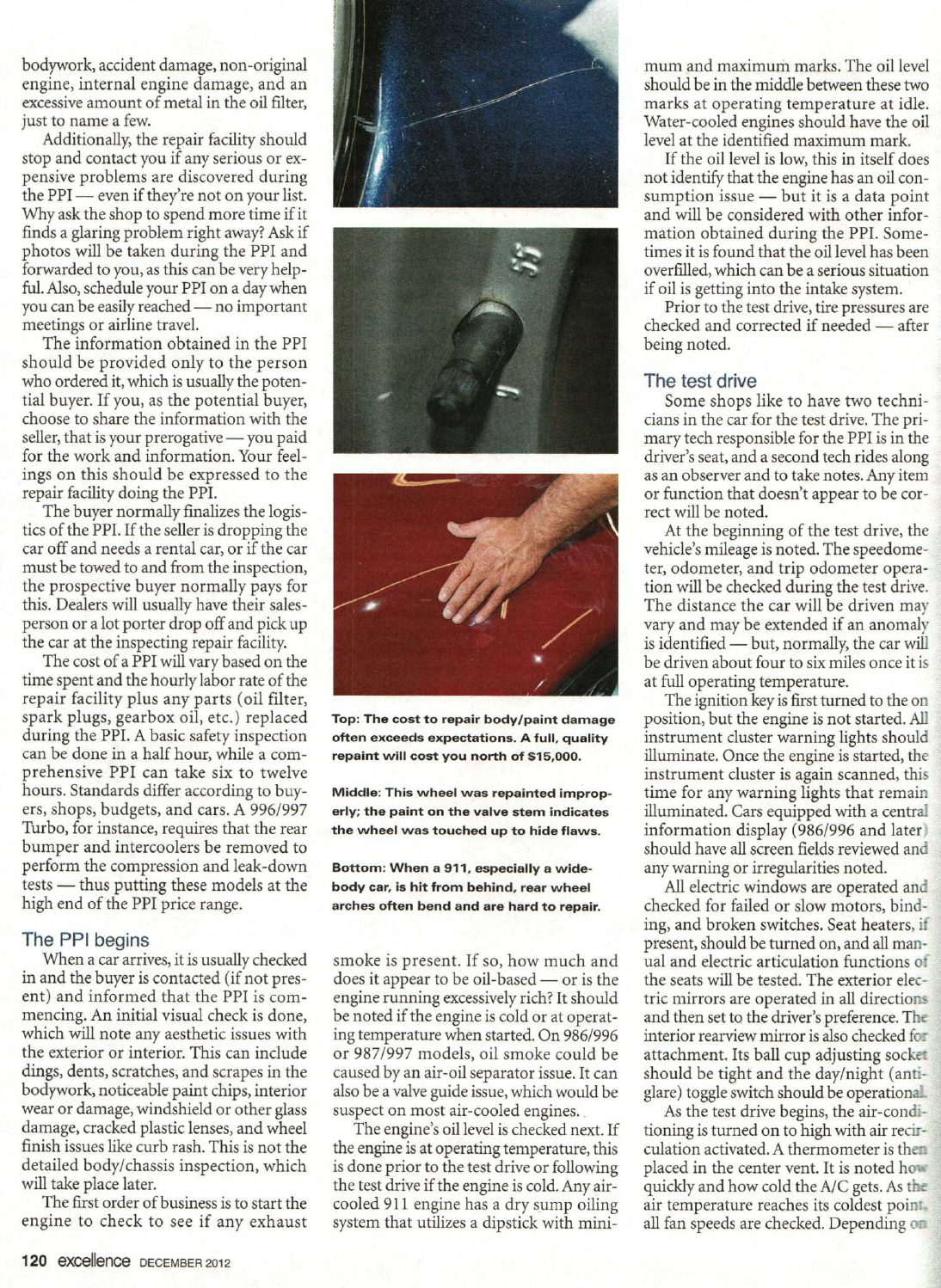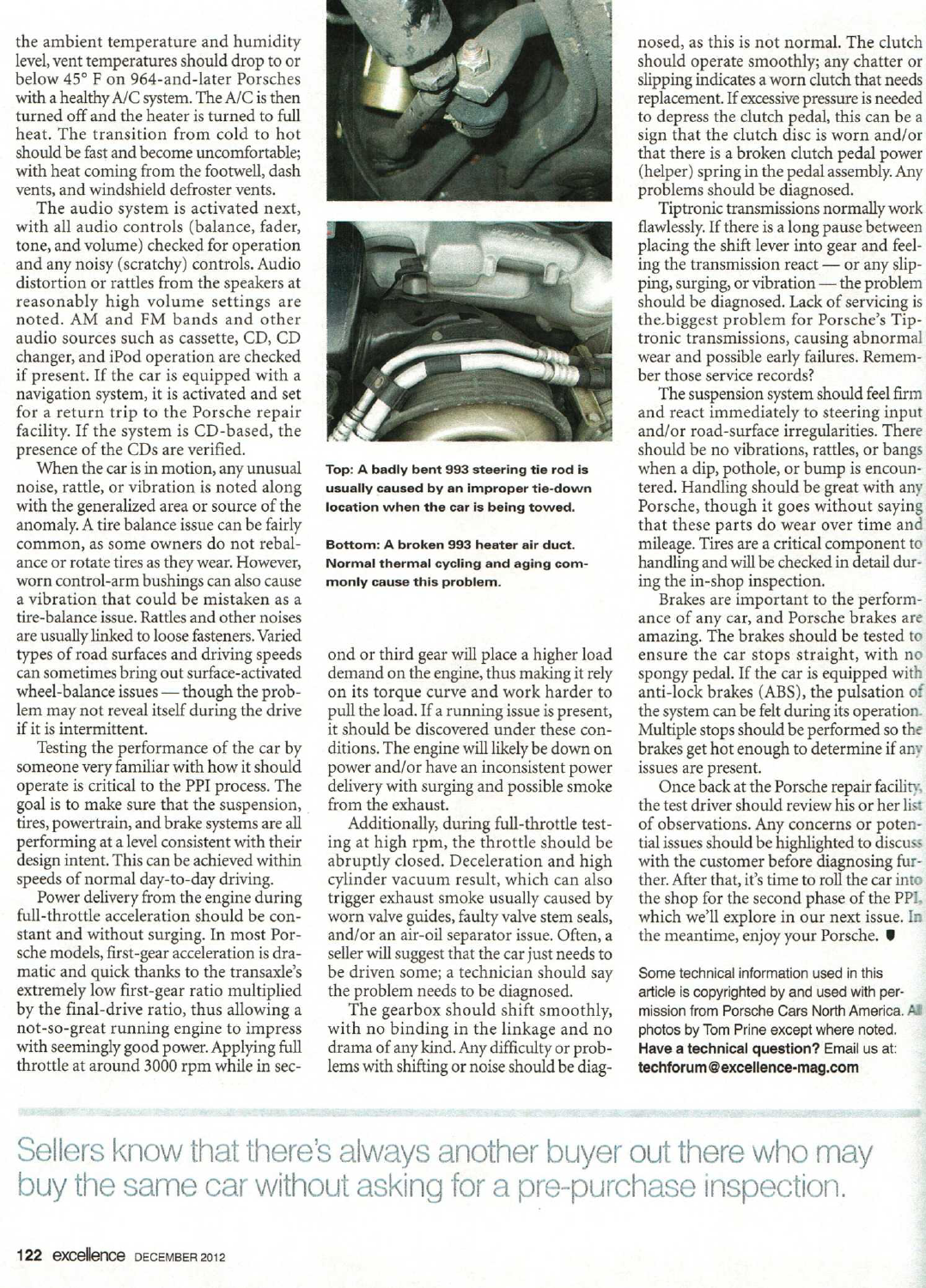
tech forum
BY TONY CALLAS & TOM PRINE
Pre-purchase Inspections 101
T
oday, as throughout Porsche's history,
when a new Porsche passes its final
inspections and leaves the factory, it meets
a quality standard that is among the high-
est in the world. Once sold, the first owner
and all that subsequently follow become
the responsible caretakers of these extraor-
dinary and complex machines.
Some Porsche owners maintain their
cars to the highest standards to preserve
their aesthetic and mechanical condition.
Others may extend out services and accept
a higher degree of wear and tear. There are
also those who cannot truly afford the car
and allow it to fall into disrepair. Over
years of operation, each Porsche develops
a unique history based on use, mainte-
nance, repair, modifications, and/or acci-
dents. What all of these cars have in com-
mon is that, at some point in time, each
will be offered for sale.
As a prospective Porsche buyer, you
should consider that any pre-owned Por-
sche has the potential for significant cost
to you beyond its purchase price. Any car
can have problems, disclosed or not.
Having the right questions in mind can go
a long way toward protecting you from
nasty surprises. How did the owner — and
any previous owner(s) — maintain the
car? Was it properly serviced? Were high-
quality parts and correct mechanical and
accident repair practices utilized? Were
corners cut to save money?
If you're looking for a popular but rare
model, a specific exterior color, or a partic-
ular group of options, you may find your
dream car is located far away, in another
state. If you buy on emotion, you might find
yourself in a situation where you're paying
big repair bills to correct previous neglect,
abuse, substandard workmanship, and/or
collateral damage. A better solution: Make
your purchase contingent on the car pass-
ing a comprehensive pre-purchase inspec-
tion, commonly referred to as a
"PPI."
A comprehensive PPI is a process some-
what like that of a forensic investigation,
where experience and technology are uti-
lized to investigate and establish facts. The
PPI should be performed at a professional
Porsche repair facility, and conducted by
a technician who is highly experienced
with the year and model you are looking
at. Through an in-shop evaluation and
extended test drive, a technician collects
and documents empirical data on all areas
and systems of the car.
These areas may include perform-
ance, mechanicals, chassis/body/paint,
safety systems, and electronic and elec-
trical equipment/systems. A compression
and leak-down test of each cylinder is
needed to indicate the mechanical con-
dition of the engine.
For
computer-con-
trolled cars, the PPI should also include
a complete electronic interrogation of
the onboard computers to confirm the
car's operating history and the presence
of any system faults at the time of the
PPI. Sometimes, additional diagnostic
time is needed for specific problems,
such as unusual running issues, elec-
tronic faults, oil leaks, etc.
A PPI may even reveal things about a
car that the owner/dealer doesn't know or
is trying to hide. If the price can be estab-
lished for the work needed to rectify any
problems, these findings can sometimes
be utilized to negotiate a lower selling
price. That said, if you have already nego-
tiated the price with the seller, he or she
may or may not be willing to go down fur-
ther on price regardless of the issues.
Sellers, whether private parties or deal-
ers, will discuss price — but they know
that there's always another buyer out there
who may be impulsive and buy the same
car without asking for the PPI.
In this
Tech Forum,
we'll take
a
general
look at buying a used Porsche and more
specifically at the Pre-purchase Inspection,
what it is, and how it can save you far more
money than it costs.
The Porsche hood crest—and the hood itself—can be damaged when pressure
is applied to the emblem to close the hood.
DECEMBER 2012
excellence
117

Pre-PPI advice
Prior to even getting to the PPI, you
should consider a few things to ensure that
the car being looked into is worthy of your
pursuit — including your investment of
time and money. Give some thought to
what Porsche model really interests you.
That may sound somewhat odd, but for a
first-time Porsche buyer or even a current
owner, it is well worth taking the time to
test-drive different models to help you
decide what you really like.
Understand that Porsches are expensive
to maintain. Porsche has always produced
well-balanced, high-performance cars uti-
lizing quality components and workman-
ship throughout. That said, as the miles
add up, standard maintenance items will
be needed. Tires, brakes, hoses, belts,
struts/shocks, clutch, fluid changes and/or
flushes, minor and major services, and
other repairs all add up. Be prepared to set
aside a minimum of $2,000-3,000 per year
for maintenance. You may not spend this
full amount each year, but in the long run
it will balance out. This is something first-
time Porsche buyers often underestimate.
Do your due diligence; learn as much
as you can about the model(s) you are
pursuing. Any car can have an unexpected
breakdown, but be sure you understand
any underlying issue you may face and
how to avoid those potential problems.
There are many sources of information
available online and, of course, here in the
pages of
Excellence.
You can also
utilize
the
knowledge of your local Porsche repair
facility; generate a list of questions and
make an appointment to meet with the
staff and let them address your concerns.
When you find a car that interests you,
do not get emotional. Instead, look at the
car as if you were checking it out for your
best friend. Be discriminating. If there are
obvious problems, there may be more
lurking that you cannot see. The goal here
is to find a good car, not to become a pro-
fessional PPI customer and have car after
car inspected. Everyone wants a bargain,
which most people equate to an inexpen-
sive purchase price. However, in the world
of Porsche ownership, you are far better
off buying a car in exceptional condition
and maintaining it that way. Be prepared
to walk away from a car if it suffers from
neglect. You can fix many things about a
car, but, in these cases, bigger and more
expensive issues can be waiting.
Ask the seller to let you review the fac-
tory maintenance book and repair receipts
going back to when the car was new. These
records validate the car's service and repair
history, thus giving you the proof of when
and where the work was performed. Of
Top: The Cabriolet top, over time and expo-
sure
to the elements, can develop dry rot
and separate. There is no "repair," except
to install an expensive replacement top.
Middle: The numbering seen on this tire is
its
manufacture date; "5204" indicates the
52nd week of 2004.
Bottom: When old tires are dried out and
cracked, they should be replaced ASAP.
course, some owners may remove selective
receipts regarding items deemed to be
embarrassing or problematic.
If the owner has only a few receipts or
none at all, this should be viewed as a neg-
ative. It does not necessarily mean the car
is bad, however seeing and having this
documentation is an important data point
to you as a prospective buyer. The owner's
memory and stories are not good enough;
there will be a day when you too will be
selling the car, and having the full records
makes your car more desirable and poten-
tially valuable to a selective buyer.
A stamped and dated factory mainte-
nance book can provide some basic infor-
mation, but these are usually filled in only
if the owner requests it. Services like Car-
Fax
can
be a source of information —
especially accident history — but data on
service and repairs can be sketchy depend-
ing on where the car was serviced.
You can also contact Porsche Cars
North America at 1(800) PORSCHE. You
will need to provide the complete Vehicle
Identification Number (VIN). If the car
was dealer-serviced they should be able to
direct you to that dealer. Keep in mind, a
Porsche dealer or independent repair facil-
ity will not disclose a previous owner's
personal information — but they may be
willing to verbally discuss with you the
details of the work they performed.
A PPI may uncover maintenance or
repair issues that should be addressed
soon after purchasing the car. Be prepared
to invest a few thousand dollars or more
to bring the services current and make any
repairs that have the potential of getting
worse or causing collateral damage to
other components or systems.
Setting up a PPI
It
is best to find and contact the shop
you want to perform the PPI a few days
prior to when you need the work com-
pleted. If the car you are considering is
outside your local area, out of state, or
cross-country, you should enlist the help
of your local or national Porsche club to
assist you in finding a well-known and
well-recommended repair facility.
Not all repair facilities will perform a
PPI; this is generally due to the potential
for liability should they make a mistake
and/or the disruption of their customer
scheduling. Most repair facilities can
appreciate that the
PPI
can be time-sen-
sitive and will usually work you into their
schedule as soon as possible.
The Porsche repair facility you hire to
perform a PPI should not be the same
company where the seller normally does
business. Even if this facility is conve-
niently located to the seller, it may not be
in your best interest. While there may be
no issue of impropriety, you should have
fresh eyes doing this work.
Call and discuss what the shop nor-
mally inspects during a PPI and, if this di
fers from your needs, explain what areas
you want them to focus on. If you cannot
be present during the PPI, it is very impor-
tant that you inform the repair facility of
anything that is a "deal killer" for you —
noting that the PPI should be stopped ti
such a problem is encountered. Our expe-
rience with some buyers' "deal killer" con-
ditions include partially or fully repainted
118
excellence
DECEMBER 2012

bodywork, accident damage, non-original
engine, internal engine damage, and an
excessive amount of metal in the oil filter,
just to name a few.
Additionally, the repair facility should
stop and contact you if any serious or ex-
pensive problems are discovered during
the PPI — even if they're not on your list.
Why ask the shop to spend more time if it
finds a glaring problem right away? Ask if
photos will be taken during the PPI and
forwarded to you, as this can be very help-
ful. Also, schedule your PPI on a day when
you can be easily reached — no important
meetings or airline travel.
The information obtained in the PPI
should be provided only to the person
who ordered it, which is usually the poten-
tial buyer. If you, as the potential buyer,
choose to share the information with the
seller, that is your prerogative — you paid
for the work and information. Your feel-
ings on this should be expressed to the
repair facility doing the PPI.
The buyer normally fmali7es the logis-
tics of the PPI. If the seller is dropping the
car off and needs a rental car, or if the car
must be towed to and from the inspection,
the prospective buyer normally pays for
this. Dealers will usually have their sales-
person or a lot porter drop off and pick up
the car at the inspecting repair facility.
The cost of a PPI will vary based on the
time spent and the hourly labor rate of the
repair facility plus any parts (oil filter,
spark plugs, gearbox oil, etc.) replaced
during the PPI. A basic safety inspection
can be done in a half hour, while a com-
prehensive PPI can take six to twelve
hours. Standards differ according to buy-
ers, shops, budgets, and cars. A 996/997
Turbo, for instance, requires that the rear
bumper and intercoolers be removed to
perform the compression and leak-down
tests — thus putting these models at the
high end of the PPI price range.
The PPI begins
When a car arrives, it is usually checked
in and the buyer is contacted (if not pres-
ent) and informed that the PPI is com-
mencing. An initial visual check is done,
which will note any aesthetic issues with
the exterior or interior. This can include
dings, dents, scratches, and scrapes in the
bodywork, noticeable paint chips, interior
wear or damage, windshield or other glass
damage, cracked plastic lenses, and wheel
finish issues like curb rash. This is not the
detailed body/chassis inspection, which
will take place later.
The first order of business is to start the
engine to check to see if any exhaust
Top: The cost to repair body/paint damage
often exceeds expectations. A full, quality
repaint will cost you north of $15,000.
Middle: This wheel was repainted improp-
erly; the paint on the valve stem indicates
the wheel was touched up to hide flaws.
Bottom: When a 911, especially a wide-
body car, is hit from behind, rear wheel
arches often bend and are hard to repair.
smoke is present. If so, how much and
does it appear to be oil-based — or is the
engine running excessively rich? It should
be noted if the engine is cold or at operat-
ing temperature when started. On 986/996
or 987/997 models, oil smoke could be
caused by an air-oil separator issue. It can
also be a valve guide issue, which would be
suspect on most air-cooled engines.
The engine's oil level is checked next. If
the engine is at operating temperature, this
is done prior to the test drive or following
the test drive if the engine is cold. Any air-
cooled 911 engine has a dry sump oiling
system that utilizes a dipstick with mini-
mum and maximum marks. The oil level
should be in the middle between these two
marks at operating temperature at idle.
Water-cooled engines should have the oil
level at the identified maximum mark.
If the oil level is low, this in itself does
not identify that the engine has an oil con-
sumption issue — but it is a data point
and will be considered with other infor-
mation obtained during the PPI. Some-
times it is found that the oil level has been
overfilled, which can be a serious situation
if oil is getting into the intake system.
Prior to the test drive, tire pressures are
checked and corrected if needed — after
being noted.
The test drive
Some shops like to have two techni-
cians in the car for the test drive. The pri-
mary tech responsible for the PPI is in the
driver's seat, and a second tech rides along
as an observer and to take notes. Any item
or function that doesn't appear to be cor-
rect will be noted.
At the beginning of the test drive, the
vehicle's mileage is noted. The speedome-
ter, odometer, and trip odometer opera-
tion will be checked during the test drive.
The distance the car will be driven may
vary and may be extended if an anomaly
is identified — but, normally, the car will
be driven about four to six miles once it is
at full operating temperature.
The ignition key is first turned to the on
position, but the engine is not started. All
instrument cluster warning lights should
illuminate. Once the engine is started, the
instrument cluster is again scanned, this
time for any warning lights that remain
illuminated. Cars equipped with a central
information display (986/996 and later=
should have all screen fields reviewed and
any warning or irregularities noted.
All electric windows are operated and
checked for failed or slow motors, bind-
ing, and broken switches. Seat heaters, if
present, should be turned on, and all man-
ual and electric articulation functions of
the seats will be tested. The exterior elec-
tric mirrors are operated in all directions
and then set to the driver's preference. The
interior rearview mirror is also checked for
attachment. Its ball cup adjusting socket
should be tight and the day/night (anti-
glare) toggle switch should be operational.
As the test drive begins, the air-condi-
tioning is turned on to high with air recir-
culation activated. A thermometer is then
placed in the center vent. It is noted how
quickly and how cold the A/C gets. As the
air temperature reaches its coldest point.
all fan speeds are checked. Depending on
120
excellence
DECEMBER 2012

the ambient temperature and humidity
level, vent temperatures should drop to or
below 45° F on 964-and-later Porsches
with a healthy A/C system. The A/C is then
turned off and the heater is turned to full
heat. The transition from cold to hot
should be fast and become uncomfortable;
with heat coming from the footwell, dash
vents, and windshield defroster vents.
The audio system is activated next,
with all audio controls (balance, fader,
tone, and volume) checked for operation
and any noisy (scratchy) controls. Audio
distortion or rattles from the speakers at
reasonably high volume settings are
noted. AM and FM bands and other
audio sources such as cassette, CD, CD
changer, and iPod operation are checked
if present. If the car is equipped with a
navigation system, it is activated and set
for a return trip to the Porsche repair
facility. If the system is CD-based, the
presence of the CDs are verified.
When the car is in motion, any unusual
noise, rattle, or vibration is noted along
with the generalized area or source of the
anomaly. A tire balance issue can be fairly
common, as some owners do not rebal-
ance or rotate tires as they wear. However,
worn control-arm bushings can also cause
a vibration that could be mistaken as a
tire-balance issue. Rattles and other noises
are usually linked to loose fasteners. Varied
types of road surfaces and driving speeds
can sometimes bring out surface-activated
wheel-balance issues — though the prob-
lem may not reveal itself during the drive
if it is intermittent.
Testing the performance of the car by
someone very familiar with how it should
operate is critical to the PPI process. The
goal is to make sure that the suspension,
tires, powertrain, and brake systems are all
performing at a level consistent with their
design intent. This can be achieved within
speeds of normal day-to-day driving.
Power delivery from the engine during
full-throttle acceleration should be con-
stant and without surging. In most Por-
sche models, first-gear acceleration is dra-
matic and quick thanks to the transaxle's
extremely low first-gear ratio multiplied
by the final-drive ratio, thus allowing a
not-so-great running engine to impress
with seemingly good power. Applying full
throttle at around 3000 rpm while in sec-
Top: A badly bent 993 steering tie rod is
usually caused by an improper tie-down
location when the car is being towed.
Bottom: A broken 993 heater air duct.
Normal thermal cycling and aging com-
monly cause this problem.
and or third gear will place a higher load
demand on the engine, thus making it rely
on its torque curve and work harder to
pull the load. If a running issue is present,
it should be discovered under these con-
ditions. The engine will likely be down on
power and/or have an inconsistent power
delivery with surging and possible smoke
from the exhaust.
Additionally, during full-throttle test-
ing at high rpm, the throttle should be
abruptly closed. Deceleration and high
cylinder vacuum result, which can also
trigger exhaust smoke usually caused by
worn valve guides, faulty valve stem seals,
and/or an air-oil separator issue. Often, a
seller will suggest that the car just needs to
be driven some; a technician should say
the problem needs to be diagnosed.
The gearbox should shift smoothly,
with no binding in the linkage and no
drama of any kind. Any difficulty or prob-
lems with shifting or noise should be diag-
nosed, as this is not normal. The clutch
should operate smoothly; any chatter or
slipping indicates a worn clutch that needs
replacement. If excessive pressure is needed
to depress the clutch pedal, this can be a
sign that the clutch disc is worn and/or
that there is a broken clutch pedal power
(helper) spring in the pedal assembly. Any
problems should be diagnosed.
Tiptronic transmissions normally work
flawlessly. If there is a long pause between
placing the shift lever into gear and feel-
ing the transmission react — or any slip-
ping, surging, or vibration — the problem
should be diagnosed. Lack of servicing is
the.biggest problem for Porsche's Tip-
tronic transmissions, causing abnormal
wear and possible early failures. Remem-
ber those service records?
The suspension system should feel firm
and react immediately to steering input
and/or road-surface irregularities. There
should be no vibrations, rattles, or bangs
when a dip, pothole, or bump is encoun-
tered. Handling should be great with any
Porsche, though it goes without saying
that these parts do wear over time and
mileage. Tires are a critical component to
handling and will be checked in detail dur-
ing the in-shop inspection.
Brakes are important to the perform-
ance of any car, and Porsche brakes are
amazing. The brakes should be tested to
ensure the car stops straight, with no
spongy pedal. If the car is equipped with
anti-lock brakes (ABS), the pulsation of
the system can be felt during its operation_
Multiple stops should be performed so the
brakes get hot enough to determine if any
issues are present.
Once back at the Porsche repair facility.
the test driver should review his or her list
of observations. Any concerns or poten-
tial issues should be highlighted to discuss
with the customer before diagnosing fur-
ther. After that, it's time to roll the car into
the shop for the second phase of the PP!.
which we'll explore in our next issue. In
the meantime, enjoy your Porsche.
•
Some technical information used in this
article is copyrighted by and used with per-
mission from Porsche Cars North America. At
photos by Tom Prine except where noted.
Have a technical question?
Email us at:
Sellers know that there's always another buyer out there who may
buy the same car without asking for a pre-purchase inspection.
122
excellence
DECEMBER 2012
